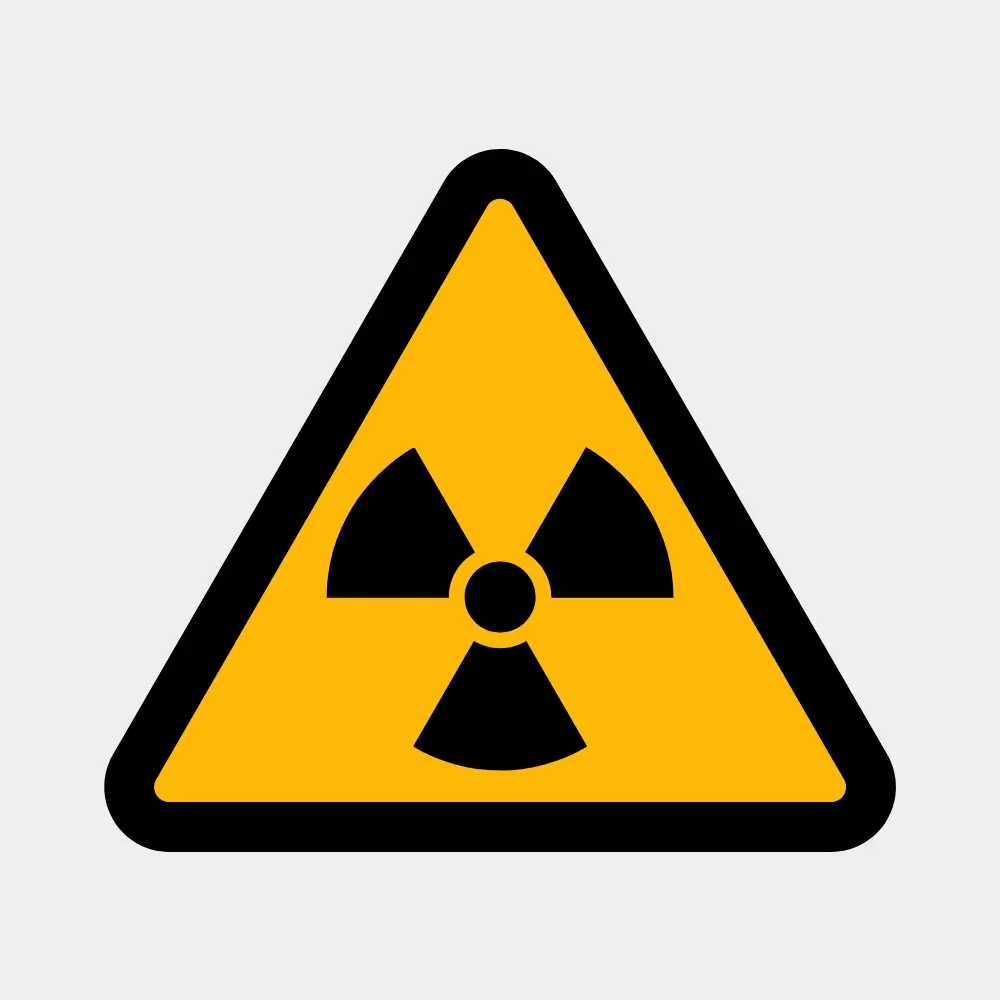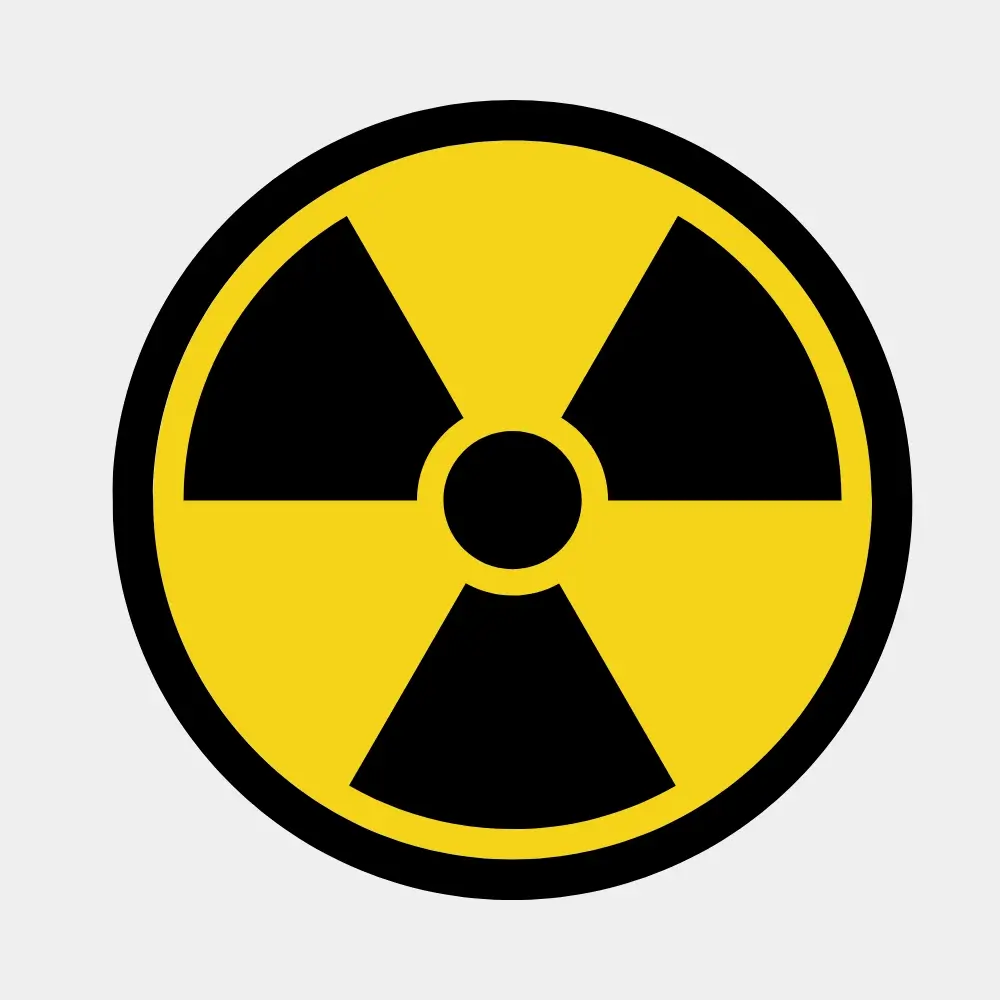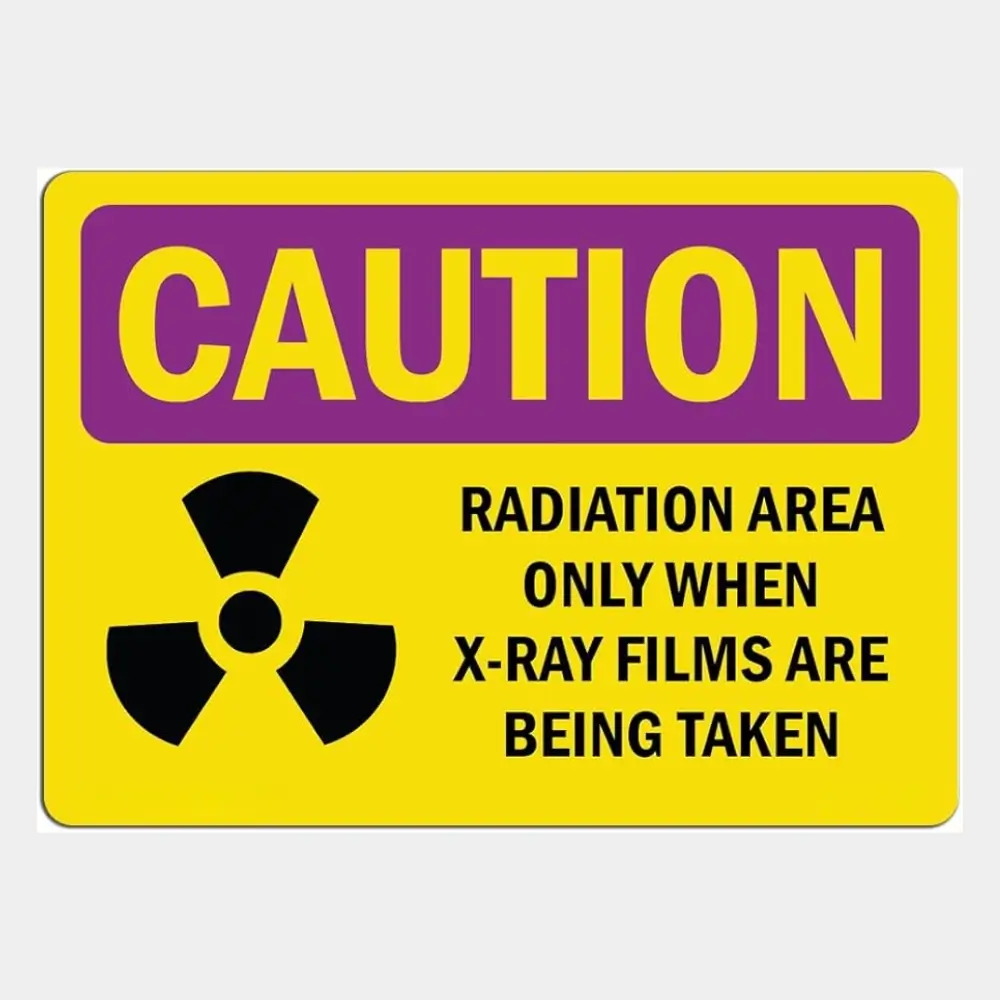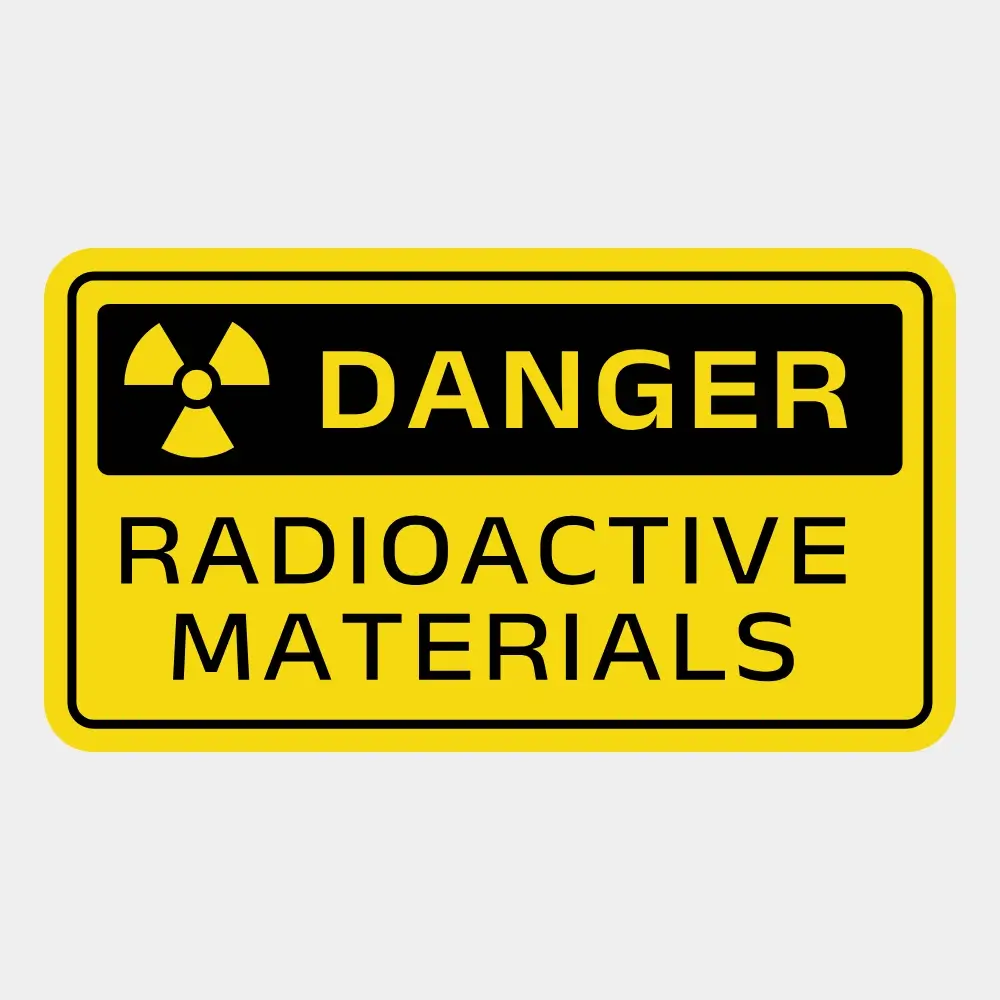Radiation is an invisible force vital to modern science, medicine, industry, and energy. However, its potential hazards make it critical to recognize and respect the warnings associated with it. The radiation symbol, commonly known as the trefoil, is one of the most important tools for ensuring safety. This universally recognized icon serves as a warning for the presence of ionizing radiation, guiding individuals to take precautions and avoid exposure.
In this blog, we’ll explore the radiation symbol in-depth, covering its meaning, origin, and practical uses. You’ll learn about the symbol’s history, the various types of radiation warning signs, and real-world examples of its usage.
Additionally, we’ll delve into the modern supplementary radiation warning symbols designed to enhance public understanding and safety. Finally, we’ll provide actionable guidance on responding to a radiation symbol to stay safe in environments with potential radiation hazards.

What is the Radiation Symbol?
The radiation symbol is a warning designed to signify areas, equipment, or materials with ionizing radiation. Its purpose is to prevent accidental exposure to harmful radiation levels.
What Does the Radiation Symbol Mean?
The radiation symbol is not merely a design but a crucial safety indicator. It conveys the following messages:
- Caution: Presence of radiation that could harm human health.
- Restriction: Entry to the marked area is limited to authorized or properly equipped personnel.
- Awareness: Signals the need for specific precautions like wearing protective gear.
Design of the Symbol
The radiation symbol features:
- Central Circle: Represents the source of radiation.
- Three Blades: Symbolize radiation emanating outward.
- Yellow Background: Ensures visibility and serves as a universal caution color.
- Colors: The blades are typically black or magenta on a yellow background, chosen for high visibility.

History of the Radiation Symbol
The radiation symbol, or trefoil, was created in 1946 at the University of California, Berkeley, to warn of ionizing radiation visually. Its original design featured a magenta trefoil on a blue background, representing radiation spreading from a central source.
In 1948, the colors were standardized to black or magenta on a yellow background for better visibility. Organizations like the International Atomic Energy Agency (IAEA) and the International Organization for Standardization (ISO) later adopted this global standard.
In 2007, a supplementary symbol with a skull, crossbones, and running figure was introduced for high-risk scenarios. Today, the trefoil remains a universal warning for radiation hazards.

Types of Radiation Warning Signs
Radiation warning signs use specific language and symbols to communicate the level of hazard associated with ionizing radiation. These signs help individuals take appropriate precautions in environments where radiation exposure may occur. Here’s a detailed breakdown of the types of radiation warning signs:
1. Basic Radiation Warning Sign

Features the trefoil symbol with no additional text.
- Purpose: Indicates the presence of ionizing radiation.
- Examples of Use: On equipment that generates radiation, such as X-ray machines and near areas with low-level radioactive materials.
- Message: Awareness of radiation hazards without specifying severity.
2. “Caution: Radiation Area”

Includes the trefoil symbol and the text “Caution: Radiation Area.”
- Purpose: Warns of areas where radiation levels could exceed 5 milligrams (mrem) per hour.
- Examples of Use: Laboratories using radioactive isotopes and rooms housing equipment like CT scanners.
- Message: Restricted access; follow safety protocols.
3. “Caution: High Radiation Area”

Description: Includes the trefoil symbol and the text “Caution: High Radiation Area.”
- Purpose: Alerts individuals to areas where radiation levels could exceed 100 mrem per hour.
- Examples of Use: Around industrial radiography equipment and certain zones in nuclear power plants.
- Message: Enhanced risk; protective measures required for entry.
4. “Danger: High Radiation Area”

Uses stronger language with “Danger” instead of “Caution.”
- Purpose: Emphasizes a higher level of risk in areas with elevated radiation.
- Examples of Use: Close proximity to radiation therapy machines and high-powered industrial or research facilities.
- Message: Serious hazard; strict safety compliance necessary.
5. “Grave Danger: Very High Radiation Area”

Features the trefoil symbol with the text “Grave Danger: Very High Radiation Area.”
- Purpose: Indicates zones where radiation levels could exceed 500 rads per hour, posing life-threatening risks.
- Examples of Use: Around damaged nuclear reactors and areas storing high-level radioactive waste.
- Message: Lethal risk; entry is forbidden without specific authorization and protection.
6. Supplementary Radiation Symbol (Post-2007)
Combines the trefoil with additional elements like:
- Radiating waves (indicating radiation).
- A skull and crossbones (representing danger).
- A running figure (urging people to flee).
| Purpose | Warns the general public of extreme dangers, particularly from sealed radioactive sources or high-risk equipment. |
| Examples of Use | Devices containing high-intensity radioactive materials and equipment used in remote or non-professional environments. |
| Message | Aimed at deterring tampering and ensuring public safety. |
Key Takeaways
- Each type of radiation warning sign corresponds to a specific hazard level, ranging from general awareness to life-threatening risks.
- These signs help enforce safety standards and reduce the risk of accidental exposure in workplaces, medical facilities, research centers, and public spaces.

Examples of Radiation Symbol Usage
The radiation symbol, commonly known as the trefoil, is used in various settings to warn about the presence of ionizing radiation. Its applications span multiple industries, including healthcare, energy, research, and public safety. Below is a detailed overview of where and how this symbol is used:
1. Medical Applications
a) X-Ray Rooms
- The radiation symbol is prominently displayed at the entrance of X-ray rooms in hospitals and clinics.
- Purpose: To warn patients and staff about the use of ionizing radiation during imaging procedures, ensuring only authorized personnel enter.
b) Nuclear Medicine Departments
- Used in facilities where radioactive isotopes are utilized for diagnostic tests (e.g., PET scans) or treatments (e.g., cancer radiotherapy).
- Purpose: To highlight the presence of radioactive substances that require specialized handling and safety precautions.
c) Radiation Therapy Equipment
- Found on devices used for treating cancer through targeted radiation.
- Purpose: To alert users to potential exposure during operation.
2. Industrial Applications
a) Nondestructive Testing (NDT)
- Radiation is used in industrial radiography to inspect materials for flaws without damaging them.
- Purpose: Signs with the radiation symbol are placed near testing equipment to restrict access and protect workers.
b) Nuclear Power Plants
- The symbol is used extensively within nuclear facilities to mark high-radiation areas, storage units, and machinery.
- Purpose: To guide workers in avoiding exposure and adhering to safety protocols.
c) Mining
- Found in uranium mines or facilities processing radioactive materials.
- Purpose: To warn workers of radioactive ore and implement protective measures.
3. Research and Education
a) Laboratories
- Commonly used in research labs dealing with radioactive substances or radiation-producing equipment (e.g., particle accelerators).
- Purpose: To designate restricted areas and ensure proper handling of hazardous materials.
b) Universities
- Displayed in physics and chemistry departments where radiation is part of academic or experimental activities.
- Purpose: To maintain safety in environments where students and researchers may interact with radioactive sources.
4. Public Safety
a) Transportation of Radioactive Materials
- Containers and vehicles transporting radioactive materials are required to display the symbol.
- Purpose: To alert handlers and emergency responders to potential hazards.
b) Radioactive Waste Storage
- The symbol is used to mark facilities or containers storing radioactive waste.
- Purpose: To prevent accidental exposure and unauthorized access.
5. Consumer Products
- Found on certain products containing small amounts of radioactive material (e.g., smoke detectors, luminous watches, and compasses).
- Purpose: To indicate compliance with safety standards and warn users of the presence of low-level radiation.
6. Military and Defense
- Used in areas handling nuclear weapons or in facilities managing radioactive components.
- Purpose: To highlight risks and enforce strict safety measures.
7. High-Risk Warning Signs
- Example: “Grave Danger: Very High Radiation Area”
- Found in zones where radiation levels could result in a lethal dose within minutes (e.g., around damaged nuclear reactors).
- Purpose: To emphasize the extreme risk and prevent unauthorized entry.
The radiation symbol is crucial for maintaining safety across various environments. Marking areas and equipment with radiation hazards ensures that individuals are aware of the dangers and take necessary precautions to avoid exposure.

Supplementary Radiation Warning Symbols
The traditional trefoil radiation symbol is effective for trained personnel, but it may not sufficiently warn the general public or non-specialists about the dangers of high-risk radiation sources. To address this, the International Atomic Energy Agency (IAEA) and the International Organization for Standardization (ISO) introduced a supplementary radiation warning symbol in 2007.
Design of the Supplementary Symbol
The supplementary radiation warning symbol is designed to convey a stronger, more universally understood warning about radiation dangers. It includes:
- Traditional Trefoil Symbol: Positioned at the top, representing the radiation source.
- Radiating Waves: Indicating the emission of ionizing radiation.
- Skull and Crossbones: Universal symbol for lethal danger, highlighting the risk of death.
- Running Figure: Depicted fleeing the danger, urging people to stay away or evacuate.
- Colors: Red background, black symbols, and white highlights for maximum visibility and urgency.
Purpose
The supplementary symbol is specifically intended for:
- High-Risk Radiation Sources: These are sealed radioactive sources used in medical, industrial, and research equipment.
- Public Safety: To discourage tampering or unintentional exposure by untrained individuals.
- Universal Understanding: Ensures that even those unfamiliar with the trefoil symbol or radiation can recognize the danger.
Where It Is Used
- Medical Devices: High-intensity radiation equipment like cancer treatment machines.
- Industrial Equipment: Devices containing potent radioactive sources for testing and inspections.
- Radioactive Waste Containers: High-risk storage or disposal sites.
- Transportation of High-Risk Materials: Packaging or vehicles carrying dangerous radioactive substances.
Key Benefits
- Clarity: Combines universally recognized danger symbols with action-oriented imagery.
- Prevention: Reduces accidental exposure or tampering by uninformed individuals.
- Safety Assurance: Ensures clear communication of extreme radiation risks, even in non-specialist environments.
Comparison with the Traditional Trefoil
| Feature | Traditional Trefoil | Supplementary Symbol |
|---|---|---|
| Target Audience | Trained personnel | General public and non-specialists |
| Level of Warning | General caution | Extreme danger |
| Additional Elements | None | Skull, crossbones, running figure |
| Color Scheme | Yellow and magenta/black | Red, black, and white |
The supplementary radiation warning symbol complements the traditional trefoil by providing an enhanced visual and emotional impact. It ensures universal comprehension and encourages people to avoid high-risk radiation areas or equipment, significantly improving safety in public and industrial settings.

How to Respond to a Radiation Symbol
When you encounter a radiation symbol, it is critical to respond appropriately to ensure your safety and the safety of others. The radiation symbol, also known as the trefoil, indicates the presence of ionizing radiation, which can be harmful if proper precautions are not taken. Here’s how to respond step by step:
1. Stop and Assess
- Pause Immediately: Do not proceed further when you see a radiation symbol.
- Read the Sign: Look for accompanying text (e.g., “Caution: Radiation Area” or “Danger: High Radiation Area”) to understand the level of hazard.
- Evaluate Your Need to Enter: Determine if your presence in the area is essential.
2. Understand the Context
- Low-Level Radiation: Exposure may be minimal for signs with general warnings, but precautions are still necessary.
- High-Risk Areas: If the sign warns of “High Radiation” or “Very High Radiation,” exposure can be dangerous or life-threatening.
- Supplementary Symbols: If you see the supplementary symbol with a skull and crossbones, treat the area as extremely hazardous and avoid entry unless fully trained and equipped.
3. Follow Safety Protocols
For Authorized Personnel:
- Wear Protective Gear: As required, wear radiation shields, lead aprons, gloves, or other personal protective equipment (PPE).
- Use Dosimeters: Carry a radiation dosimeter to measure your exposure levels.
- Limit Time in the Area: Minimize the time spent in radiation zones to reduce cumulative exposure.
- Follow the Safety Plan: Adhere to all safety protocols established by your organization or facility.
For General Public:
- Do Not Enter: Avoid the area entirely unless you are trained and authorized.
- Alert Authorities: Notify the facility’s safety personnel if you notice missing or damaged warning signs.
4. Leave Immediately If Unprepared
If you find yourself in a radiation area without proper knowledge or equipment:
- Exit Promptly: Leave the area following the same path you entered.
- Avoid Touching Anything: Do not handle materials or objects that may be radioactive.
- Inform Authorities: Report the situation to the facility’s safety team or local emergency services.
5. Report Unusual Situations
- If you see:
- Faded or Missing Signs: Report to the facility manager or regulatory body.
- Damaged Equipment: Notify relevant authorities to address potential radiation leaks.
6. In Case of Emergency Exposure
- Move to Safety: Immediately evacuate to a safe area away from the radiation source.
- Decontaminate: If there is suspected contamination (e.g., radioactive particles on your skin or clothing), follow decontamination procedures:
- Remove contaminated clothing.
- Wash skin thoroughly with soap and water.
- Seek Medical Attention: Inform medical personnel about the exposure for proper evaluation and treatment.
Key Takeaways
- Always treat radiation symbols with caution, even in areas you frequent.
- Never ignore radiation warnings, as exposure risks can have severe health consequences.
- Only trained individuals with the appropriate protective gear and monitoring equipment should enter areas marked with radiation symbols.
- In case of doubt or emergency, prioritize evacuation and alert authorities for proper handling.
Responding appropriately to radiation symbols ensures personal safety and compliance with safety standards, preventing unnecessary exposure and mitigating risks.
Conclusion
The radiation symbol is more than just an icon; it is a universal warning system designed to protect people from the invisible dangers of ionizing radiation. By understanding its history, types, and applications and how to respond appropriately when encountering it, we can navigate environments involving radiation with greater awareness and safety.
Whether used in medical facilities, industrial settings, or public safety, the radiation symbol is crucial in minimizing risks and ensuring compliance with safety protocols. Recognizing and respecting this symbol is essential for safeguarding both individuals and communities in our radiation-dependent world.






















